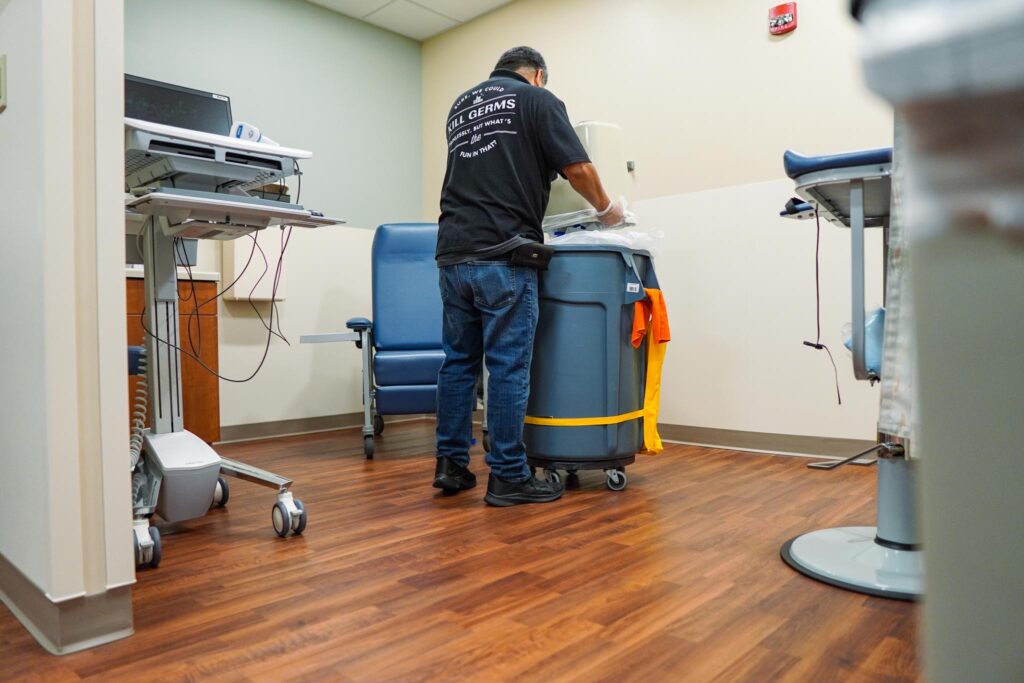When it comes to healthcare facilities, the environment is almost as important as the team of doctors. A clean, healthy environment is paramount to the safety of its inhabitants, which is why medical cleaning is so important. Although this importance has always been recognized, the recent pandemic has underscored its significance even more. Here, we’ll give you a stronger understanding of the importance of medical cleaning and how it can ensure a safe and healthy environment.
What is Medical Cleaning?
Medical cleaning is a commercial cleaning service provided to medical facilities, hospitals, and surgery centers. It goes beyond the regular cleaning practices you receive with basic janitorial cleaning or how you might clean your home. Unlike standard cleaning routines, medical cleaning adheres to stringent checklists and protocols. It utilizes advanced cleaning agents and equipment to ensure the elimination of harmful microorganisms that could pose a threat to anyone exposed.
Simply put, medical cleaning is designed to maintain the health and safety of all healthcare facilities, from clinics and hospitals to laboratories and cleanrooms. It’s essential to the health and safety of visitors, staff, and, most importantly, patients. Medical cleaning can reduce the risk of cross-contamination, lower healthcare-acquired infections, and maximize the operational efficiency of your facility. However, it involves a comprehensive approach to cleaning that covers things such as sanitization and disinfection.
Sanitization and Disinfection
Medical cleaning extends beyond cleaning for appearance. It focuses on cleaning for health. This means thoroughly sanitizing and disinfecting surfaces to eradicate harmful germs and pathogens. This is especially important in healthcare settings where vulnerable individuals with compromised immune systems are present.
Specialized Equipment and Supplies
Within the realm of medical cleaning, you need a little more than a mop and a bucket. High-quality medical cleaning uses specialized equipment such as high-efficiency particulate air (HEPA) vacuums, EPA-certified cleaning products, and advanced cleaning protocols to help eradicate germs in various settings. This ensures that the risk of cross-contamination is minimized and the health and safety of your facility are maximized.
Waste Management
Proper disposal of hazardous materials is another integral part of medical cleaning. It ensures that hazardous waste, such as used needles and biological waste, are safely disposed of to prevent the spread of infections and maintain a clean environment.
How Can Medical Cleaning Promote a Safe and Healthy Environment?
Medical cleaning is one of the best lines of defense against infections. It helps improve the overall safety and well-being of patients, staff, and visitors without disrupting your day-to-day operations. This, in turn, has several benefits. Some of the many ways that medical cleaning can promote a safe and healthy environment include the following:
Infection Prevention
With a constant flow of sick individuals and visiting family members, hospitals and clinics are breeding grounds for pathogens. Medical cleaning significantly reduces the risk of healthcare-associated infections (HAIs) by eradicating harmful germs and microorganisms from surfaces. This not only safeguards patients but also maintains the credibility and trustworthiness of medical institutions.
Enhanced Air Quality
Proper cleaning practices can help improve indoor air quality, reducing the number of contaminants floating around. This, in addition to the proper ventilation system, is crucial for preventing the spread of airborne infections and allergens in healthcare facilities.
Reduced Cross-Contamination
During commercial cleaning services of medical facilities, emphasis is placed on high-touch surfaces like doorknobs, handrails, and medical equipment. Targeting these areas reduces the risk of cross-contamination, which can lead to a healthier overall environment.
Limiting Healthcare-Associated Infections
Healthcare-associated infections (HAIs) are a major concern in medical facilities. By implementing rigorous medical cleaning protocols, the risk of HAIs is significantly reduced. This can help shorten hospital stays, lower healthcare costs, and improve patient outcomes.
Positive Patient Outcomes
Even if HAIs don’t impact patients, their environment is a big part of their recovery. It’s no surprise that patients who are in a clean, well-maintained environment tend to have a better recovery process. This is because cleanliness helps reduce feelings of stress or psychological strain while supporting a healthy immune system. Medical cleaning also helps reduce allergens and irritants that can trigger respiratory problems.
Preventing the Spread of Antibiotic-Resistant Bacteria
Unfortunately, antibiotic-resistant bacteria, or “superbugs,” are on the rise. While proper administration and use of prescriptions is one way to help reduce the risk of resistance developing, medical cleaning can also help. Maintaining a sterile environment and using appropriate disinfectants can minimize the development and spread of these dangerous bacteria.
Ensuring Proper Functionality of Medical Equipment
Regular cleaning of medical equipment is important to maintain functionality over the years. In fact, preventative cleaning services can make all your assets last longer. This means fewer expenses for repairs or replacements over time.
Supporting Regulatory Compliance
Healthcare facilities are subject to strict health and safety regulations. Adhering to rigorous cleaning standards ensures compliance with these regulations, which can help you avoid potential legal issues and maintain the facility’s reputation.
Staff Safety and Productivity
Commercial cleaning in medical facilities also helps protect your staff. Regular cleaning of workspaces, restrooms, and communal areas provides a safe environment for staff, thus reducing their exposure to infectious agents and promoting their overall health. Clean and organized workspaces also enhance staff productivity, allowing them to focus more on their tasks and offer better patient care.
Creating a Positive First Impression
Patients and visitors want to walk into a healthcare facility and see clean, pristine areas. Hygienic areas help them feel more confident in the quality of care provided. If they were to walk into your waiting room or reception area and see trash, dirty floors, and piles of dust bunnies, you better believe they’ll turn around and find a different facility. Medical cleaning ensures that the aesthetics of your facility match your quality of care.
Encouraging Positive Visitor Behavior
Finally, medical cleaning can help encourage positive visitor behavior. When plenty of signs are posted and the areas are kept clean, visitors and patients are more likely to adopt better hygiene practices, which in turn help prevent the spread of infection.
Medical facilities are responsible to their patients, staff, and the community. Although their main focus is to help individuals who are sick or managing chronic conditions, it’s essential to do everything possible to reduce the risk of the transmission of germs. To help you get the most out of your efforts without wasting precious resources, partner with a certified medical-grade cleaning company like Bee Line. As the region’s leading medical-grade cleaning company, Bee Line provides unparalleled attention to detail regarding medical facilities. Our team is equipped with the knowledge, supplies, and protocol necessary for eradicating common diseases from surfaces and delivering the highest standards of medical-grade cleaning services.
To learn more about our medical-grade cleaning procedures, receive a quote, or reach our emergency services, contact Bee Line today by calling 312-BEE-LINE.
About The Author
Jamie Henry
author
Jamie established Bee Line in 1997 and hasn’t looked back since! She is originally from Chicago, but lived in Florida for 10 years, and claims that she is a “displaced New Yorker” despite never living there. In her free time, you can find Jamie walking her pup, Moose, around the city, and learning new hobbies, like learning to golf and piloting planes! Her favorite part of leading Bee Line is working with her team to grow the company and cultivate a positive and thriving culture. Jamie won a 19th Annual Enterprising Women of the Year Award, one of the most prestigious recognition programs for women business owners in the U.S. and globally!




